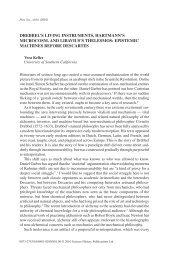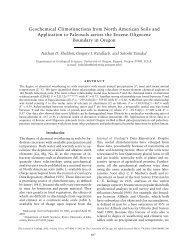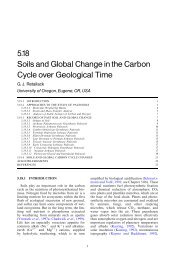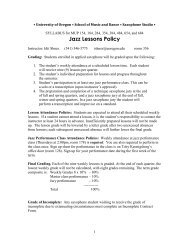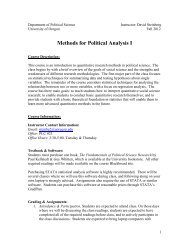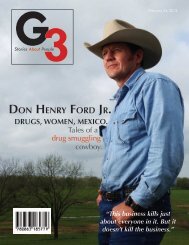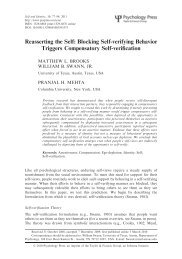Retallack 2007 Proserpina principle - University of Oregon
Retallack 2007 Proserpina principle - University of Oregon
Retallack 2007 Proserpina principle - University of Oregon
Create successful ePaper yourself
Turn your PDF publications into a flip-book with our unique Google optimized e-Paper software.
References 27<strong>Retallack</strong> G. J. (1999b) Permafrost palaeoclimate <strong>of</strong> Permianpalaeosols in the Gerringong volcanics <strong>of</strong> New SouthWales. Austral. J. Earth Sci. 46, 11–22.<strong>Retallack</strong>, G. J. (2000a) Ordovician life on land and EarlyPaleozoic global change. In Phanerozoic TerrestrialEcosystems (eds. R. A. Gastaldo and W. A. DiMichele)Paleont. Soc. Short Course Notes, Carnegie Museum,Pittsburg, vol. 6, pp. 21–45.<strong>Retallack</strong> G. J. (2000b) The <strong>Proserpina</strong> <strong>principle</strong>: a role forsoil communities in regulating atmospheric compositionon time scales ranging from ecological to geological.Abstr. Geol. Soc. Am. 32(7), A486.<strong>Retallack</strong> G. J. (2001a) Soils <strong>of</strong> the Past, 2nd edn. Blackwell,Oxford.<strong>Retallack</strong> G. J. (2001b) A 300 million year record <strong>of</strong>atmospheric CO 2 from fossil plant cuticles. Nature 411,287–290.<strong>Retallack</strong> G. J. (2001c) Scoyenia burrows from Ordovicianpaleosols <strong>of</strong> the Juniata Formation in Pennsylvania.Palaeontology 44, 209–235.<strong>Retallack</strong> G. J. (2001d) Cenozoic expansion <strong>of</strong> grasslandsand global cooling. J. Geol. 109, 407–426.<strong>Retallack</strong> G. J. (2002) Carbon dioxide and climate overthe past 300 Myr. Phil. Trans. Roy. Soc. London A 360,659–674.<strong>Retallack</strong> G. J. and Dilcher D. L. (1981) A coastal hypothesisfor the dispersal and rise to dominance <strong>of</strong> floweringplants. In Paleobotany, Paleoecology and Evolution (ed.K. J. Niklas). Praeger, New York, vol. 2, pp. 27–77.<strong>Retallack</strong> G. J. and Dilcher D. L. (1986) Cretaceous angiosperminvasion <strong>of</strong> North America. Cretaceous Res. 7,227–252.<strong>Retallack</strong> G. J. and Krinsley D. H. (1993) Metamorphicalteration <strong>of</strong> a Precambrian (2.2 Ga) paleosolfrom South Africa revealed by back-scatter imaging.Precamb. Res. 63, 27–41.<strong>Retallack</strong> G. J. and Krull E. S. (1999) Ecosystem shift atthe Permian–Triassic boundary in Antarctica. Austral. J.Earth Sci. 46, 785–812.<strong>Retallack</strong> G. J. and Mindszenty A. (1994) Well preservedLate Precambrian paleosols from northwest Scotland. J.Sedim. Res. A 64, 264–281.<strong>Retallack</strong> G. J. and Storaasli M. (1999) Problematic impressionsfrom the Precambrian <strong>of</strong> Montana. Abstr.Geol. Soc. Am. 31(7), A362.<strong>Retallack</strong> G. J., Bestland E. A., and Fremd T. (2000)Eocene and Oligocene paleosols in central <strong>Oregon</strong>. Geol.Soc. Am. Spec. Pap. 344, 192.<strong>Retallack</strong> G. J., Krull E. S., and Bockheim J. G. (2001) Newgrounds for reassessing the palaeoclimate <strong>of</strong> the SiriusGroup, Antarctica. Geol.Soc.LondonJ.158, 925–935.Rice C. M., Ashcr<strong>of</strong>t W. A., Batten D. J., Boyce A. J.,Caulfield J. B. D., Fallick A. E., Hole M. J., Jones E.,Pearson M. J., Rogers G., Saxton J. M., Stuart F. M.,Trewin N. H., and Turner G. (1995) A Devonian auriferoushot spring system, Rhynie, Scotland. Geol. Soc.London J. 152, 229–250.Rich T. H. and Vickers-Rich P. T. (2000) Dinosaurs <strong>of</strong>Darkness. <strong>University</strong> <strong>of</strong> Indiana Press, Bloomington.Rye R. and Holland H. D. (1998) Paleosols and the evolution<strong>of</strong> atmospheric oxygen: a critical review. Am. J. Sci.298, 621–672.Rye R. and Holland H. D. (2000) Life associated with a2.76 Ga ephemeral pond? Evidence from Mount Roe #2paleosol. Geology 28, 483–486.Rye R., Kuo P. H., and Holland H. D. (1995) Atmosphericcarbon dioxide concentrations before 2.2 billion yearsago. Nature 378, 603–605.Schidlowski M. and Aharon P. (1992) Carbon cycle andcarbon isotopic record: geochemical impact <strong>of</strong> life over3.8 Ga <strong>of</strong> Earth history. In Early Organic Evolution:Implications for Energy and Mineral Resources (eds.M. Schidlowski, S. Golubic, M. M. Kimberley, D. M.McKirdy, and P. A. Trudinger). Springer, Berlin,pp. 147–175.Schidlowski M., Hayes J. M., and Kaplan I. R. (1983) Isotopicinferences <strong>of</strong> ancient biochemistries: carbon, sulfur,hydrogen and nitrogen. In Earth’s Earliest Biosphere: ItsOrigin and Evolution (ed. J. W. Schopf). Princeton<strong>University</strong> Press, Princeton, pp. 149–186.Schmidt P. W. and Williams G. E. (1999) Palaeomagnetism<strong>of</strong> the Palaeoproterozoic hematitic breccia and paleosolat Ville-Marie, Quebec: further evidence for the low palaeolatitude<strong>of</strong> Huronian glaciation. Earth Planet. Sci.Lett. 172, 273–285.Schmitt J. M. (1999) Weathering, rainwater and atmosphericchemistry: an example and modeling <strong>of</strong> graniteweathering in present conditions, in a CO 2 rich and in ananoxic palaeoatmosphere. In Palaeoweathering, Palaeosurfacesand Continental Deposits (eds. M. Thiry andR. Simon-Coinc¸on). Int. Assoc. Sedimentology Spec.Publ., Blackwell, Oxford, vol. 27, pp. 21–41.Schumm S. A. (1956) The role <strong>of</strong> creep and rainwash on theretreat <strong>of</strong> badland slopes. Am. J. Sci. 254, 693–706.Schwartzmann D. W. and Volk T. (1991) Biotic enhancement<strong>of</strong> weathering and surface temperatures <strong>of</strong> Earthsince the origin <strong>of</strong> life. Palaeogeogr. Palaeoclimatol.Palaeoecol. 90, 357–371.Schwarz T. (1997) Lateritic paleosols in central Germanyand implications for Miocene paleoclimate. Palaeogeogr.Palaeoclimatol. Palaeoecol. 129, 37–50.Serdyuchenko D. P. (1968) Metamorphosed weatheringcrusts <strong>of</strong> the Precambrian: their metallogenic and petrographicfabric. In Precambrian Geology (ed. B. Hejtman).Proc. 13th Int. Geol. Congr. Prague. Academia,Prague, vol. 4, pp. 37–42.Sheldon N. D., <strong>Retallack</strong> G. J., and Reed M. H. (2001)Siderite–iron–silicate equilibria in paleosols as an atmosphericCO 2 paleobarometer or paleoproductivity index?Abstr. Geol. Soc. Am. Geol. Soc. London Global Meet.Edinburgh, 42.Sheldon N. D., <strong>Retallack</strong> G. J., and Tanaka S. (2002)Geochemical clim<strong>of</strong>unctions from North Americansoils and application to paleosols across the Eocene–Oligocene boundary in <strong>Oregon</strong>. J. Geol. 110, 687–696.Sherwood-Pike M. A. and Gray J. (1985) Silurian fungalremains: probable records <strong>of</strong> Ascomycetes. Lethaia 18,1–20.Siegenthaler U. and Sarmiento J. L. (1993) Atmosphericcarbon dioxide and the ocean. Nature 365, 119–125.Snigirevskaya N. S., Popov L. E., and Zdebsak D. (1992)Novie nakhodki ostatkov drevnishchikh vishchikhrastenii v srednem ordovike yuzhnogo kazachstana(New findings <strong>of</strong> the oldest higher plant remains in theMiddle Ordovician <strong>of</strong> South Kazakhstan). Bot. Zh.77(4), 1–8.Soil Survey Staff (1999) Keys to Soil Taxonomy. PocahontasPress, Blacksburg, Virginia.Stallard R. F. (1998) Terrestrial sedimentation and thecarbon cycle: coupling weathering and erosion to carbonburial. Global Biogeochem. Cycles 12, 231–257.Stanley S. M. and Hardie L. A. (1999) Hypercalcification:paleontology links plate tectonics and geochemistry tosedimentology. GSA Today 9(2), 1–7.Steiner M. and Reitner J. (2001) Evidence <strong>of</strong> organic structuresin Ediacara-type fossils and associated microbialmats. Geology 29, 1119–1122.Stro¨ mberg C. A. E. (2002) The origin and spread <strong>of</strong> grassdominatedecosystems in the Late Tertiary <strong>of</strong> NorthAmerica: preliminary results concerning the evolution <strong>of</strong>hypsodonty. Palaeogeogr. Palaeoclimatol. Palaeoecol.177, 59–75.Strother P. (2000) Cryptospores: the origin and evolution<strong>of</strong> the terrestrial flora. In Phanerozoic TerrestrialEcosystems (eds. R. A. Gastaldo and W. A. DiMichele).Paleont, Soc. Short Course Notes, vol. 6, pp. 3–20.



